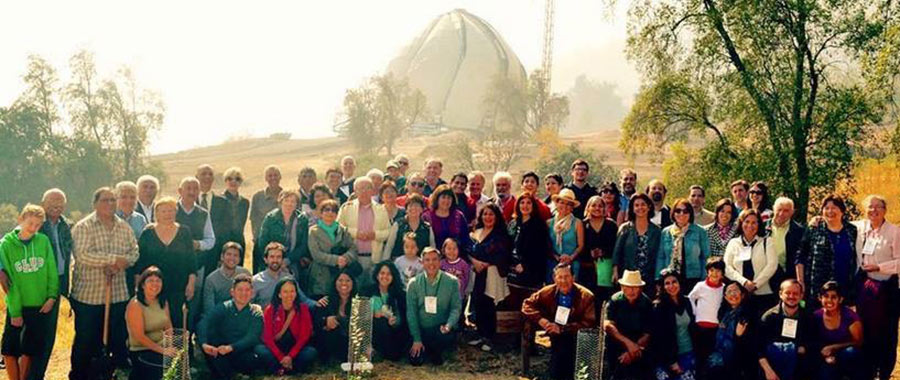In the annals of religious history, few events have garnered as much global resonance as the Bicentenary of Bahá’u’lláh, the founder of the Bahá’í Faith. Commemorated with profound reverence and widespread initiatives, this momentous occasion inspires reflections that transcend mere traditional observances. One such initiative, that emerges as both symbolic and functional, is the “Gift of Trees.” This program not only serves as a tribute to Bahá’u’lláh’s legacy but also encapsulates deeper philosophical teachings rooted in the core tenets of the Bahá’í Faith.
At the heart of the Bahá’í teachings lies the concept of interconnectedness—between individuals, communities, and the natural world. The act of gifting trees can be perceived as a metaphorical gesture that embodies this interconnectedness. Trees, as living entities, are more than mere flora; they are emblematic of sustainability, growth, and the nurturing of life itself. In gifting trees, Bahá’í followers are prompted to reflect on their responsibilities towards the environment and humanity. Such actions evoke a profound question: why do we choose trees as vessels of remembrance and respect?
This choice reveals an intricate web of observations; trees symbolize strength, resilience, and permanence. They grow steadily, offering shelter, sustenance, and beauty, thereby nurturing both the ecological balance and a spiritual affinity for the environment. The act of planting a tree provides a tangible illustration of Bahá’u’lláh’s teachings on the oneness of humanity and the need to cultivate both our internal and external landscapes. A tree, once planted, not only endures but flourishes over time, mirroring the ongoing evolution of spiritual ideals in society.
Moreover, the gifting of trees serves as an invitation to individuals and communities to engage in the sacred act of stewardship for the planet. This nurturing role is vital in an era marked by environmental degradation and climate challenges. By fostering a relationship with nature through the act of planting, adherents partake in a reawakening of awareness towards their ecological duties. This dynamic reflects Bahá’u’lláh’s emphasis on the essential harmony between material and spiritual life—a principle that directs humanity towards sustainable living.
Beyond ecological stewardship, the Gift of Trees resonates with the Bahá’í principles of unity and peace. The event offers an opportunity for interfaith dialogue and communal collaboration, emphasizing the collective responsibility to care for the earth. Such collective action echoes the Bahá’í assertion that “the earth is but one country, and mankind its citizens.” The planting of trees serves as a unifying act that transcends sectarian divides, encouraging diverse groups to come together for a common purpose.
Furthermore, the celebrations surrounding the Bicentenary and the associated initiatives often ennoble local histories and cultural narratives. When communities engage in tree-planting activities, they are not solely commemorating a religious figure; they are also paying homage to their local ecosystems and histories. Trees can represent ancestral legacies and cultural heritages, acting as living markers of time that connect generations. In this sense, the Gift of Trees is not merely a symbolic gesture; it is a medium through which cultures can intertwine and narratives can thrive.
As we explore the layers of this initiative, we cannot overlook the intrinsic spiritual significance of trees within Bahá’í scripture. Nature, including trees, is revered in Bahá’í texts as a reflection of the divine. In the writings of Bahá’u’lláh, the natural world is often portrayed as a manifestation of God’s attributes. Therefore, by gifting trees, followers participate in an act of devotion, recognizing the spiritual essence that pervades all creation. In this light, the Gift of Trees transcends the physical act of planting; it is a recognition of the sacredness of nature and the divine’s omnipresence in all aspects of life.
Such an initiative also prompts individuals to confront deeper existential questions about legacy and remembrance. How will we be remembered by future generations? What marks will we leave on the earth? The act of planting a tree connects the gift-giver to future stewards of the planet—children, grandchildren, and beyond. This sense of legacy invokes a much deeper reflection on the continuity of life, where the actions of the present bear significance for the future.
In synthesizing these reflections, it becomes evident that the Gift of Trees during Bahá’u’lláh’s Bicentenary is multifaceted and rich in meaning. It serves as a bridge between the physical and spiritual realms and as an avenue for promoting environmental responsibility, fostering community unity, and exemplifying cultural heritage. This initiative transcends mere observance; it invigorates narratives of coexistence and reverence for nature.
Ultimately, the act of gifting trees is more than a tribute; it is a clarion call to engage meaningfully with the world. It compels Baha’is and non-Baha’is alike to contribute towards a harmonious existence in collective awareness of our shared vulnerabilities and aspirations. As followers of Bahá’u’lláh, the path forward is illuminated by love, unity, and an indomitable commitment to building a better world, one tree at a time.
